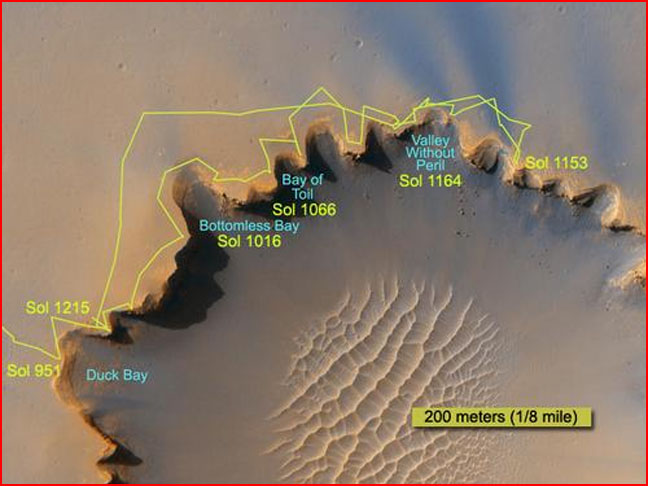
home •
about •
essential guide •
picture of the day •
thunderblogs •
news •
multimedia •
predictions •
products •
get involved •
contact
picture of the day archive subject index
This image of Victoria Crater shows the route followed by the Mars rover Opportunity during its exploration of the
rim, as NASA scientists sought the safest path for its entry into the crater. Credit: NASA/JPL
Jul 06, 2007
Victoria Crater—A PredictionAs the rover Opportunity descends into Victoria Crater on Mars, what new surprises will it reveal? We believe it likely that the so-called “sand dunes” on the crater floor will reveal glassified crests—the telltale signature of electric discharge.
In a July 3rd, 2007 New York Times article, NASA announced that the Mars exploration rover, Opportunity, will soon begin its descent into Victoria Crater. Opportunity has been perched on the rim of the crater for several months now as the mission command team planned the best way to safely re-deploy it down the steep slope.
Opportunity is one of two mobile research platforms now on the surface of Mars. A twin vehicle, Spirit, is continuing to roam the Martian surface as well. Together, the rovers have provided new tests of the electrical hypothesis. Opportunity was the first vehicle to reveal the vast numbers of bb-sized spherules on the surface, dubbed “blueberries.” Plasma physicist C J Ransom later replicated these spherules in the laboratory by blasting hematite with an electric arc. The rovers have caught electrified dust devils in action, revealing the undeniable glow discharge at their base; and remarkably, they have demonstrated how electrostatic cleaning works to the advantage of the rovers, “miraculously” clearing the solar panels of dust. But Opportunity’s images of crater morphology may be the most tantalizing of all the new data supplied by the rovers (a subject we will explore in this series of articles).
In previous Thunderbolt Pictures of the Day, we suggested that the “dunes” at the bottom of the crater were sculpted electrically. Opportunity has already been to the bottom of Endurance Crater, revealing fascinating details about its dune field, whose form is remarkably similar to that seen in the centers of other craters on Mars. Viewed close up, the smooth texture looks nothing like the present grainy floor of the crater. The formations exhibit gravity-defying folds. Indeed, by all appearances the grains simply settled into the valleys between stable, exotically configured crests. And the tendrils at the end of several dunes show what look like “cathode whiskers,” a well documented feature of electrical effects.
As far back as October 16, 2006, after Victoria crater was first photographed by the High Resolution Imaging Science Experiment (HIRISE), electrical theorist, Wal Thornhill wrote:
"I would suggest that the "sand dunes" are the result of the central arc spots, forming overlapping circular depressions... Certainly, the orthogonal ridges have more in common with a corona discharge pattern than they do with sand dunes. They may therefore be solid, glassified sand, rather like that found in dry soil following a lightning strike. Such glassified sand is known as a "fulgurite." It is noteworthy that the Apollo astronauts found clumps of glass-crusted soil near the centers of small (1 to 5 foot) craters on the lunar surface. It raised a stir because the glass was a surprise. In addition, orthogonal lineaments in the lunar soil were reported. They cannot have been there for long."
So, rather than being created “millions of years ago” by a meteorite impact, it is likely that the geology of Victoria Crater will add further support for what so many lines of evidence have already suggested: sculpting of the Martian surface by electric discharge.
NASA may persist in attributing what it has discovered on Mars to “wind erosion,” “meteor impact,” “floods of water,” and other conventional processes. But until NASA scientists acknowledge the power and far-reaching effects of electric arcs and electric winds in the Martian past, no popular theory will sufficiently explain the observations.
___________________________________________________________________________Please visit our Forum
The Electric Sky and The Electric Universe available now!

|
|

|
EXECUTIVE EDITORS:
David Talbott, Wallace Thornhill
MANAGING EDITORS:
Steve Smith, Mel Acheson
CONTRIBUTING EDITORS: Michael Armstrong, Dwardu Cardona,
Ev Cochrane,
C.J. Ransom, Don Scott, Rens van der Sluijs, Ian Tresman
WEBMASTER: Brian Talbott
Copyright 2007: thunderbolts.info
![]()
home •
thunderblogs •
forum •
picture of the day •
resources •
team •
updates •
contact us

